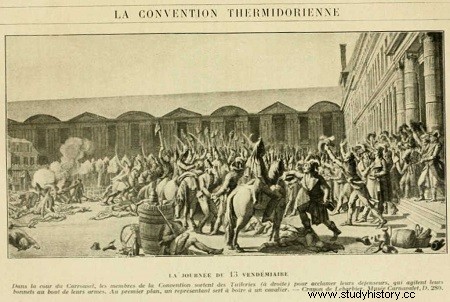
The death of Robespierre, beyond the vast movement of popular uprising , represented the end of the dictatorship of the sans-culottes. A Convention, certainly less virtuous, but free to say what it thinks, serves as an alibi for the men of the day, opportunists and speculators for many of them.
But, with the 9 -Thermidor appears a new state of mind; Certainly, it is not the return to the life of the Ancien Régime, but the golden youth enjoys exalting an easy existence, of questionable morals, where money and betting no longer make one suspect.
In a word, the spring relaxes.
In order for the revolutionary demon to be totally exorcised, it is necessary to undo the framework set up by the Terror. Thus, to break the role of the Committee of Public Safety, it is confined to matters of war and diplomacy. The police, for its part, is entrusted to the General Security Committee, while thirteen other committees are responsible for the entire administration. The political system is therefore fundamentally reorganized, since the Assembly alone governs, thus wanting to avoid the preponderance of clever men being able to exercise itself again within omnipotent committees. The law of suspects, those of 22 Prairial, the maximum, are repealed.
In order to satisfy public opinion wanting to be lost that the era of Terror is over, the great executors, if not the great leaders of the years 1794-1795, are indicted. This is how Carrier, Lebon, Fouquier-Tinville were brought before the Revolutionary Tribunal and executed. The prisons full of suspects of the Terror opened their doors, while the salons, such as those of Madame de Staël and Madame Tallien, once again housed the intellectual elite.
However, the famine continues to rage and new popular unrest will soon break out. Thus, on 12 Germinal (April 1795), the Convention was invaded by a tide of needy people demanding bread and work. Controlled, the riot only led to the arrest and deportation to Cayenne of former Jacobins, such as Barère, Collot d'Herbois and Billaud-Varenne.
Le 1er prairial ( May 20) a second insurrection broke out, much more violent than the previous one; it was repressed only after several hours of fighting and led, in turn, to the arrest and conviction of six former Jacobins.
The procession of disorders is not over however.
After having suffered terribly from the Terror, the royalists of the South-East will indulge in a counter-revolution whose excesses and horrors will have nothing to envy to those of September 1792. Paris did not escape what was called the White Terror. On 13 Vendémiaire (October 5, 1795), the royalists decided to organize in turn a Parisian day similar to that of the summer of 1792.
Wishing to obtain the repeal of the two-thirds decree ( by which the Convention had decided that at the time of its renewal, at least three thirds of its members would again be present in the new assembly), insurgents, royalists for the most part, decided to march on the Convention. But badly organized, this day is cut short. Less than a month later, the Thermidorian Convention broke up, after drafting and adopting a new Constitution, that of the Directory (Fructidor Year III).
Despite a severe economic and financial crisis, the frenzied speculation by a large number of unscrupulous politicians, the difficult balance she had to maintain between anti-Jacobin measures (closing of their clubs; disappearance of popular societies; transformation of the structures of the revolutionary movement) and royalist threats (repelled both on the forecourt of Saint-Roch* and on the Quiberon peninsula*) the Thermidorian Convention bequeathed to the Directory a significant intellectual and social heritage.
Athens was formally founded around 800 by the synoecism of several villages, partially preserved by the invasion of the Dorians. The plural of the word Athens, according to Thucydides, is a trace of the ancient villages that merged to found the city. The site was chosen for the natural fortress rep
